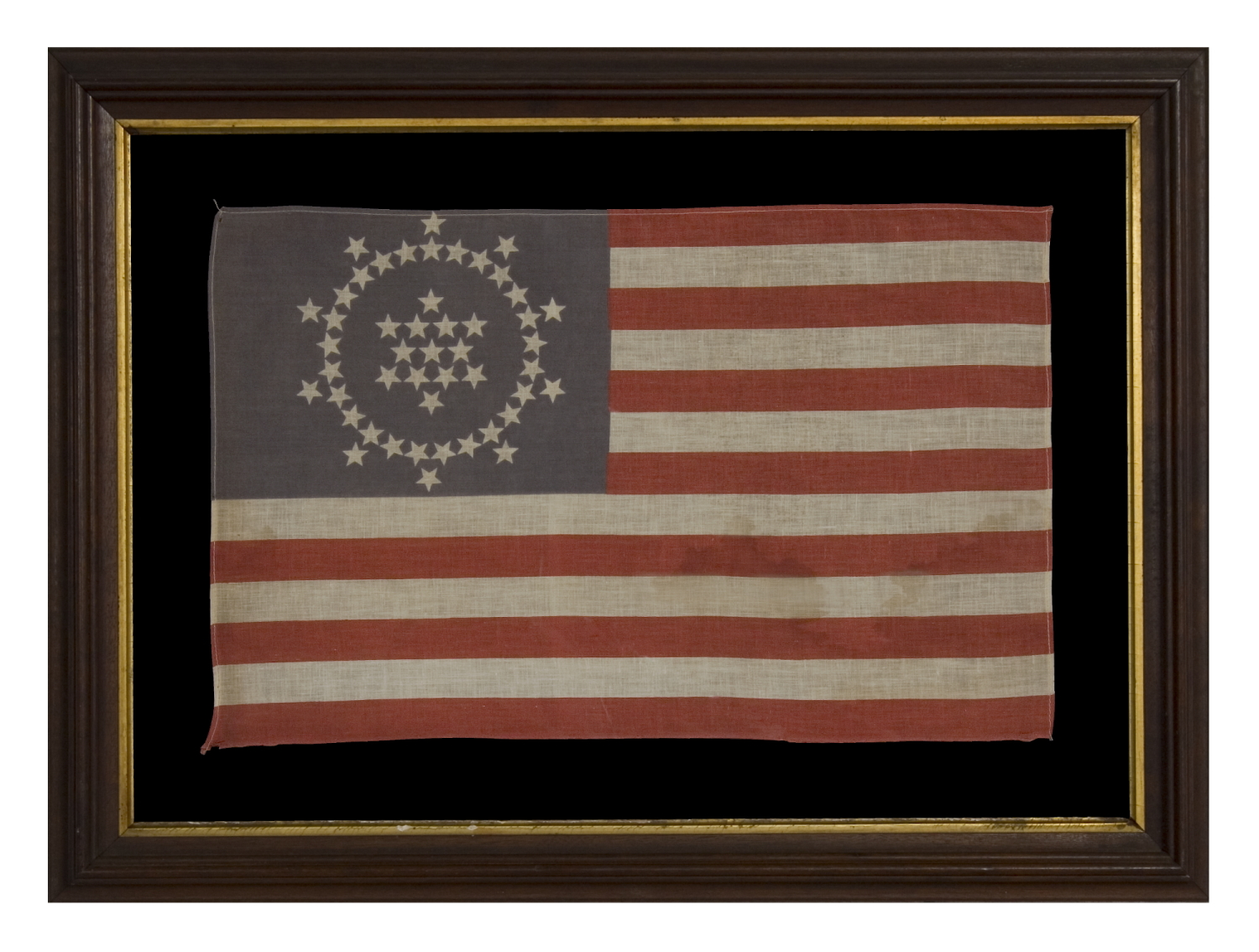
| |
48 STARS ON AN ANTIQUE AMERICAN FLAG DESIGNED AND COMMISSIONED BY WAYNE WHIPPLE, 1910-1912, A RARE AND HIGHLY DESIRED EXAMPLE |
|
| Available: |
Sold |
| Frame Size (H x L): |
23.5" x 32" |
| Flag Size (H x L): |
14" x 23" |
|
| Description....: |
|
Many people are not aware that for the first 135 years of the existence of the American national flag, there was no official way to configure its stars. In 1912, that circumstance changed with an Executive Order of President William Howard Taft. Many designs were submitted, but only one today remains common knowledge among most flag enthusiasts. A Philadelphian by the name of Wayne Whipple was one person who would proceed to solidify his name in history, designing and sub-contracting for the manufacture of his own flags, to be made in what would become known as the “Whipple” pattern.
Whipple, who worked in the publishing industry and authored about 28 books, took ads to promote the pattern. He also glorified the design in a book he released called "The Story of the American Flag" (1910, Henry Altemus Company, Philadelphia). He even went so far as to distribute small parade flag / hand-waver versions in pursuit of his goal to be the first person to design the official star pattern for the American flag. Printed on cotton or silk, he took these to rallies and mailed them to influential parties, sometimes repeatedly, accompanied by letters of solicitation. Today surviving examples of these printed flags are rare and highly desired by collectors.
The star configuration that Whipple devised included 13 stars in the center, to reflect the original 13 original colonies, arranged in a six-pointed “Great Star” pattern, like the Shield of David (Star of David). According to Whipple, this was the most logical way to display 13 stars in a star-shaped formation. The same arrangement is present on the Great Seal of the United States, which can be most readily viewed on the back of the one dollar bill.
Surrounding the Great Star was a wreath of 25 stars to represent those states that had joined the Union through the year of our nation’s 100-year anniversary in 1876. In the outermost wreath are 10 stars for those territories that gained statehood afterward, including the final two that were ushered in under the Taft administration in 1912. Whipple’s concept was that more stars could be easily added to this widely spaced outer wreath without changing the basic design, so that the pattern was not only beautiful, but also functional for a growing nation with a flag that was ever-changing.
Whipple pattern parade flags exist in both cotton and silk. This is an example of Whipple's cotton variety, which is just slightly smaller than the silk. Only two Whipple pattern flags have thus far been discovered with pieced-and-sewn construction, one of which was presented to President Taft by Whipple in 1913, then returned to Whipple and descended through the Whipple family. I have had the great privilege of owning both of these examples.
According to personal letters that were written by Whipple, along with correspondence between Whipple, the White House, and the War Department, Presidents Roosevelt and Taft both approved of and endorsed Whipple’s design. Whipple befriended both men, yet campaigned with Roosevelt in 1912. When it came to the final selection of an official configuration, the War Department’s recommendations drove Taft to select the rectilinear pattern of 6 rows of 8 stars.
Across all flags that exist in the 48 star count, the Whipple pattern doesn't only fall among the most rare and unusual, but is an easy contender in the category of most beautiful. Hardly any 48 star flags are known that do not display stars in some assemblage of linear rows; even so, the Whipple configuration is so well-balanced and attractive that it demands attention when paired with just about any star pattern of any period.
With regards to date of manufacture, Whipple's flags are also among the earliest 48 star examples. Cognizant that there were just two Western Territories yet to be added, Whipple appears to have begun work on the star pattern in the period when there were 46 states (1907-1912). Though none of his actual flags are dated, some would actually pre-date the addition of New Mexico and Arizona in 1912, which brought the star count to 48.
New Mexico gained statehood on January 6th, 1912 and was followed by Arizona on February 14th (Valentine's Day). The 48 star flag became official on July 4th, 1912, and was generally used until the addition of Alaska in 1959. It was the official flag during WWI (U.S. involvement 1917-18), WWII (U.S. involvement 1941-45) and the Korean War (1950-53).
Mounting: The flag was mounted and framed in our own conservation department, which is led by expert trained staff. We take great care in the mounting and preservation of flags and have framed thousands of examples. Feel free to contact us for more details.
The solid walnut molding has a gilded liner and dates to the period between 1870 and 1890. The background is 100% cotton twill that has been washed and treated for color-fastness. Spacers keep the textile away from the glass, which is U.V. protective.
Condition: There is minor to modest foxing and staining throughout, accompanied by moderate fading of the blue canton. The great rarity of Whipple’s flags warrants almost any condition. |
|
|
|
| Collector Level: |
Advanced Collectors and the Person with Everything |
|
| Flag Type: |
Parade flag |
|
| Star Count: |
48 |
|
| Earliest Date of Origin: |
1912 |
|
| Latest Date of Origin: |
1912 |
|
| State/Affiliation: |
Pennsylvania |
|
| War Association: |
|
|
| Price: |
SOLD |
|
| |
Views: 1366 |
|
|
|

